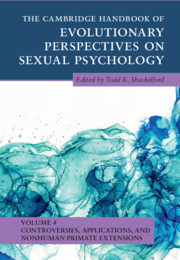Book contents
- The Cambridge Handbook of Evolutionary Perspectives on Sexual Psychology
- The Cambridge Handbook of Evolutionary Perspectives on Sexual Psychology
- Copyright page
- Contents
- Contributors
- Preface
- Part I Controversies and Unresolved Issues
- Part II Applications to Health, Law, and Pornography
- Part III Nonhuman Primate Sexual Behavior
- 14 Chimpanzee Sexual Behavior
- 15 Bonobo Sexual Behavior and Psychology
- 16 Orangutan Sexual Behavior
- 17 Gibbon Evolved Sexual Psychology
- 18 Sexual Behavior in Marmosets in the Context of Cooperative Breeding
- 19 Capuchin Sexual Behavior
- 20 Sexual Behavior in Neanderthals
- Index
- References
16 - Orangutan Sexual Behavior
from Part III - Nonhuman Primate Sexual Behavior
Published online by Cambridge University Press: 30 June 2022
- The Cambridge Handbook of Evolutionary Perspectives on Sexual Psychology
- The Cambridge Handbook of Evolutionary Perspectives on Sexual Psychology
- Copyright page
- Contents
- Contributors
- Preface
- Part I Controversies and Unresolved Issues
- Part II Applications to Health, Law, and Pornography
- Part III Nonhuman Primate Sexual Behavior
- 14 Chimpanzee Sexual Behavior
- 15 Bonobo Sexual Behavior and Psychology
- 16 Orangutan Sexual Behavior
- 17 Gibbon Evolved Sexual Psychology
- 18 Sexual Behavior in Marmosets in the Context of Cooperative Breeding
- 19 Capuchin Sexual Behavior
- 20 Sexual Behavior in Neanderthals
- Index
- References
Summary
Orangutan females live semi-solitarily, spending 50–80 percent of their time alone, with only their dependent offspring for company (van Schaik, 1999). They are philopatric (Arora et al., 2012; van Noordwijk et al., 2002) and establish their home ranges in an area that overlaps with their natal range as well as with those of other females, both maternal relatives and nonrelatives (Ashbury et al., 2020; Morrogh-Bernard, 2009). Males disperse from their natal range as they become independent of their mother around the age of ten to twelve years (Nietlisbach et al., 2012) and settle far away from their natal area. Adult males are not territorial, and their home ranges overlap with those of females, but are far larger (Singleton et al., 2009). Determining male ranging patterns is challenging because their ranging area far exceeds the size of all study areas covered by earth-bound researchers, and individual males may not be around for several months or even years (Dunkel et al., 2013; Spillmann et al., 2017; Utami Atmoko et al., 2009a). In sum, orangutans have a dispersed social and mating system with high female site fidelity and widely roaming males.
- Type
- Chapter
- Information
- Publisher: Cambridge University PressPrint publication year: 2022
References
- 3
- Cited by

